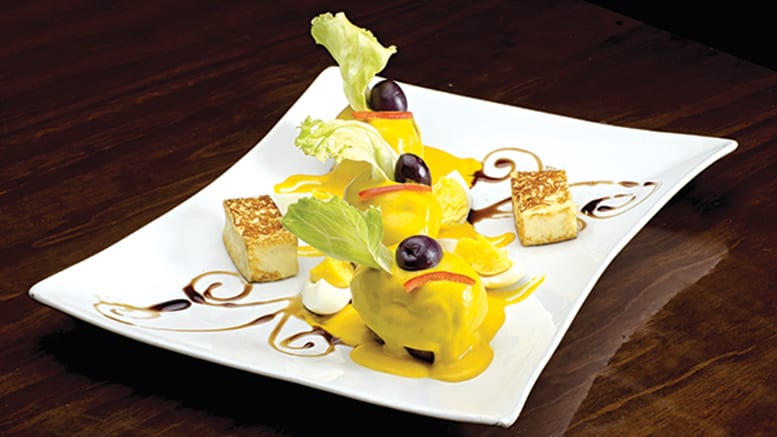The Power Of Potatoes
October 1, 2018 | 3 min to read
Potatoes remain one of the top-selling vegetables in the U.S., celebrated for their versatility and diverse menu applications. Chef RJ Harvey of Potatoes USA showcases innovative dishes like Lebanese Potato Shawarma and Pho-Tato Noodle Bowl, reflecting global culinary influences. Market research indicates that potatoes are the most loved item among consumers, with significant growth anticipated due to creative menu descriptions and appealing pairings, while traditional favorites continue to thrive alongside emerging trends.

Originally printed in the October 2018 issue of Produce Business.
 Potatoes are among the top-three selling vegetables in both retail and foodservice. Tomatoes and onions are the other two. What makes potatoes so powerful and popular? Their incredible versatility is one reason. They can be prepared in endless ways, paired with a myriad of flavors and presented on menus in ways that make the familiar exotic, exciting and new.
Potatoes are among the top-three selling vegetables in both retail and foodservice. Tomatoes and onions are the other two. What makes potatoes so powerful and popular? Their incredible versatility is one reason. They can be prepared in endless ways, paired with a myriad of flavors and presented on menus in ways that make the familiar exotic, exciting and new.
Facebook followers of chef RJ Harvey, the global marketing manager for Potatoes USA, applaud his incredible creativity in presenting potatoes in new ways. Chef RJ travels the world, exploring food cultures that give him inspiration in his test kitchen for plant-forward menu items to test with audiences here in the United States. Here are two recent potato innovation projects he presented online, inspired by Middle Eastern and South East Asian foods and flavor: Lebanese Potato Shawarma with pickled onions, Labneh Tzatziki, and tomato, Feta and mint; and Pho-Tato Noodle Bowl with potato noodles, Kombu Dashi broth, Shiitake bacon, Shanghai baby bok choi, black garlic oil, shaved yellow onion, coriander, and Thai basil.
According to foodservice market research firm Datassential, today potatoes appear on the menus of 3 out of 4 restaurants in the United States. When Datassential asks diners about their experiences with potatoes in restaurants, potatoes rank No. 1 among 312 fruits and vegetables.
Potatoes are the most tried of produce items, with 97 percent of consumers saying they’ve tried potatoes on a menu at least once (who are the 3 percent who’ve never eaten a potato-based item in a restaurant, I wonder), and 64 percent say they’ve tried potatoes multiple times.
In terms of affinity, nearly 6 out of 10 diners say they love potatoes. The only fruit or vegetable more loved by consumers is strawberries.
Datassential analysts anticipate potatoes’ menu penetration to increase by 2.3 percent over the next five years. What’s driving this growth? Innovation in menu language, inspiration from world cuisines, and perfect pairings of potatoes with sauces and dips are starting to appear on menus in fine dining restaurants.
Consumers are comforted by the fact they can find baked potatoes, potato chips, potato skins and potato salad just about anywhere. But they are also excited to discover potatoes presented in new ways on American menus.
Menu language is a critically important factor for success of new menu items. The name and descriptors must evoke a positive emotional response. Powerfully appealing language, paired with the right photo, can nearly guarantee success for a new menu item. Yet, sometimes, the simplest effort can gain traction quickly. Fine dining restaurants are having success with calling French fries “pomme frites,” using an exotic name to make the ordinary extraordinary in an upscale dining environment.
 Inspiration from world cuisines is seen in mentions of potato galettes and croquettes (from France), papa a la huancaina (from Peru), tortilla espanola and patatas bravas (from Spain), pierogi (from Central Europe), and poutine (from Quebec, Canada).
Inspiration from world cuisines is seen in mentions of potato galettes and croquettes (from France), papa a la huancaina (from Peru), tortilla espanola and patatas bravas (from Spain), pierogi (from Central Europe), and poutine (from Quebec, Canada).
Perfect pairings of potatoes with other ingredients range from the mundane to the masterful. A squeeze of lime on oven-roasted or deep-fat fried potatoes is an easy way to punch up flavor. Trendy restaurants are seeing success with frying French fries in duck fat and pairing potatoes with protein-rich foods such as eggs, pulled pork, and brisket, and using curries and salsas to intensify flavors and aromas.
Surprisingly, very little is happening with new potato varieties. Fingerling and Red Bliss are the only two varieties gaining traction. There are definitely opportunities to introduce chefs and diners to more potato varieties, especially among younger diners eager to discover the next great thing for which they can claim social media bragging rights.
Does this mean potatoes presented in familiar ways will fade away? That’s not likely. Consumers are comforted by the fact they can find baked potatoes, potato chips, potato skins and potato salad just about anywhere. But they are also excited to discover potatoes presented in new ways on American menus. Combining inspiration from world cuisines with innovation from talented culinary professionals, there are endless opportunities to present the power of potatoes on American menus.
Amy Myrdal Miller, MS, RDN, FAND is a farmer’s daughter from North Dakota, award-winning dietitian, culinary nutrition expert, and founder and president of Farmer’s Daughter Consulting, Inc. She is the director of The Culinary Institute of America Healthy Menus R&D Collaborative and a consultant for the Produce for Better Health Foundation. You can learn more about her business at www.farmersdaughterconsulting.com, and you can follow her insights on food and flavor on Twitter @AmyMyrdalMiller
22 of 30 article in Produce Business October 2018

